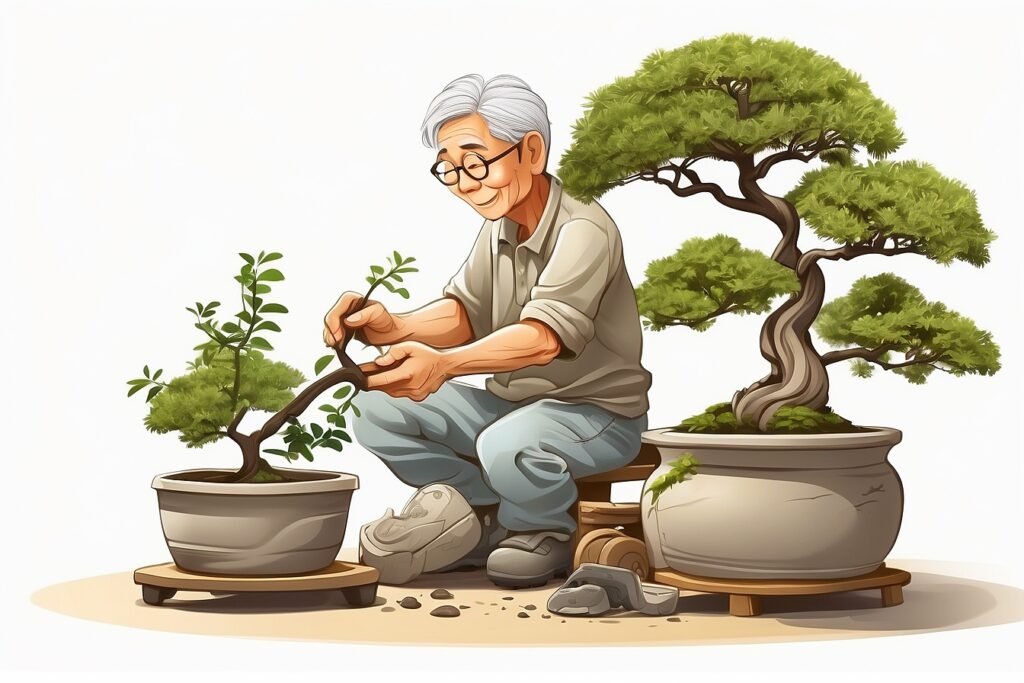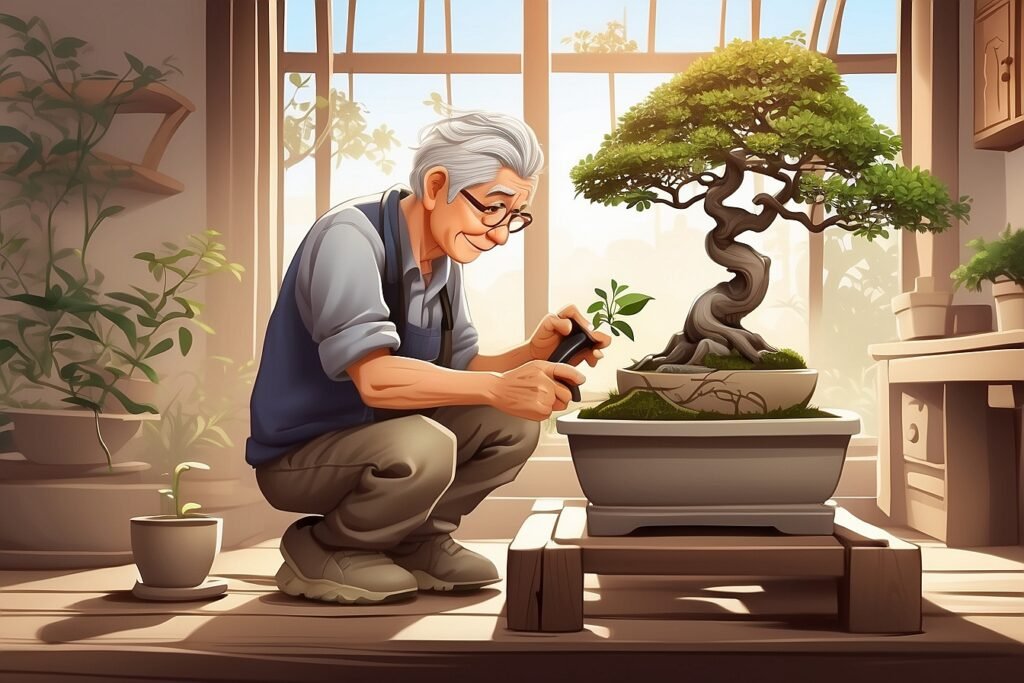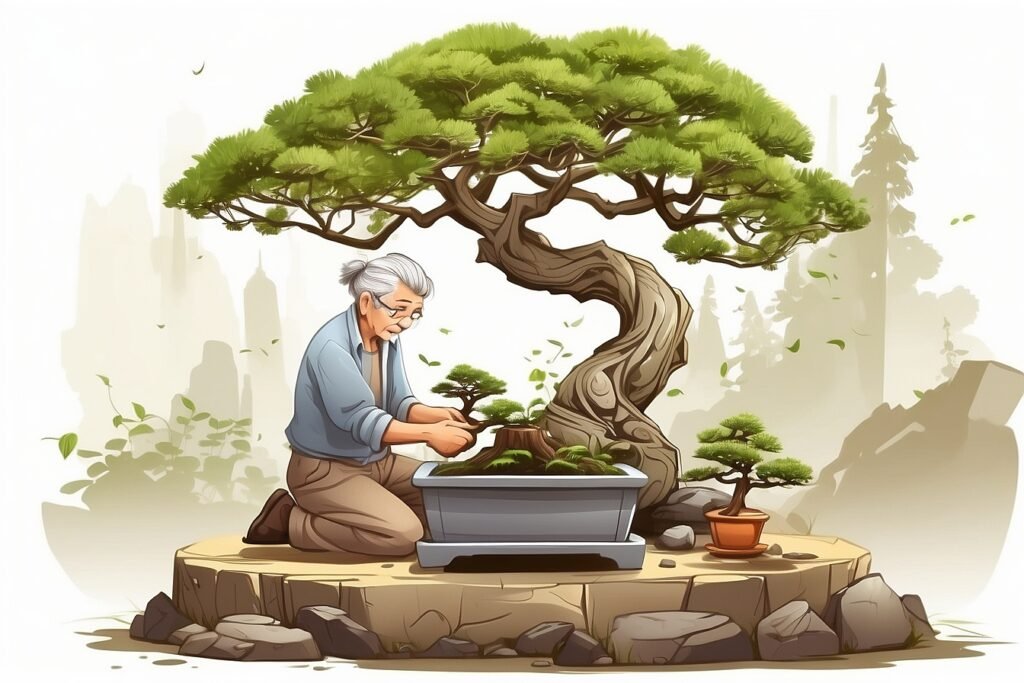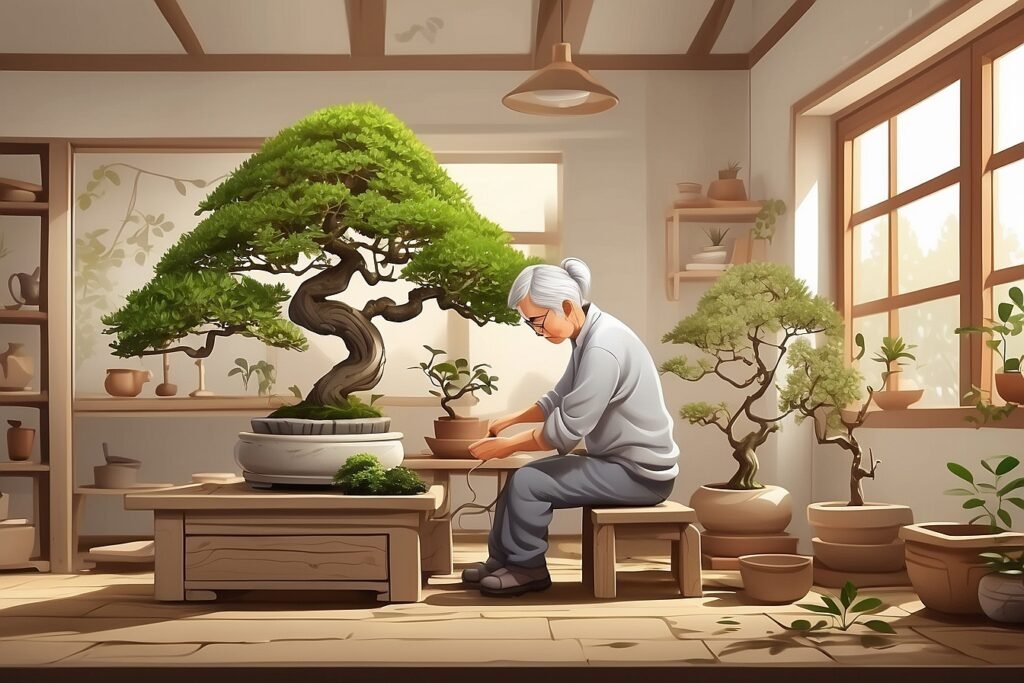Introduction

Brief Introduction to the World of Bonsai
Bonsai is more than a simple pastime. It’s an exercise in patience, balance, and a profound appreciation for nature’s majesty, albeit on a smaller scale.
| Key Elements of Bonsai | Description |
|---|---|
| Miniaturization | The process of training and pruning a tree to maintain its small size, yet mature appearance. |
| Proportion among elements | Ensuring that the size, shape, and position of the tree’s elements (e.g., trunk, branches, leaves) are proportionate. |
| Symmetry | While perfect symmetry is not always sought after in bonsai, the visual balance and harmony of the tree’s design are essential. |
| Lifelikeness | Despite the manipulation involved in bonsai, the goal is to produce a tree that mirrors nature as closely as possible. |
The Significance and Uniqueness of Black Spruce Bonsai
Black Spruce Bonsai is Scientifically known as Picea mariana, this species is celebrated in the bonsai community for its rugged allure and resilience. Its dark green needles, appealing bark, and pliable branches make it a prime candidate for various bonsai styles.
| Characteristics of Black Spruce Bonsai | Description |
|---|---|
| Dark Green Needles | These provide a striking contrast against the tree’s bark and add to its aesthetic appeal. |
| Attractive Bark | The bark of the Black Spruce Bonsai is visually pleasing, adding texture and depth to the tree’s appearance. |
| Flexible Branches | This feature allows for various styling options in the bonsai design process. |
| Adaptability | The Black Spruce Bonsai can flourish in a range of environments, making it a versatile choice for bonsai cultivation. |
Historical Context of Black Spruce Bonsai

A Look Back at the Origins of the Black Spruce Bonsai
Black Spruce Bonsai, originally comes from China over a thousand years ago, before it was refined and popularized in Japan. The Black Spruce tree is native to North America, particularly famous in the northern regions and the Appalachian Mountains. It’s plausible that when the practice of bonsai spread across the globe, enthusiasts in these regions started cultivating local trees like the Black Spruce as bonsai.
How It Has Evolved Over the Years
As a Black Spruce Bonsai cultivator, your journey will contribute to this ongoing evolution. You’ll discover new insights, techniques, and perhaps even encounter challenges that will add to the collective knowledge of this remarkable art form.
The Characteristics of Black Spruce Bonsai

Description of the Black Spruce Bonsai’s Physical Attributes
The Black Spruce Bonsai physical features contribute to its stunning aesthetic appeal. Here are some key attributes of this fantastic bonsai:
| Physical Attributes | Symbolism |
|---|---|
| Brown woody trunk and branches | Brings a small part of the forest into your home |
| Dark green needles | Beautiful and mystical |
| Durable plant | Represents resilience and strength |
| Requires little water | Symbolizes adaptability and self-sufficiency |
| Thrives in direct sunlight | Represents vitality and energy |
| Does not require fertilizing | Symbolizes simplicity and natural growth |
| Can live in various soils | Represents versatility and adaptability |
| Pruning helps maintain desired shape | Symbolizes the importance of shaping and growth |
| Propagation can be difficult | Represents patience and perseverance |
| Thrives in cooler temperatures | Symbolizes resilience in harsh conditions |
| Requires a good drainage container | Represents the need for stability and support |
| Relatively easy to maintain | Symbolizes simplicity and enjoyment |
The Journey of Cultivating a Black Spruce Bonsai

The Process of Growing a Black Spruce Bonsai from Seedling to Beautiful Bonsai
Growing a Black Spruce Bonsai from a seedling to a mature bonsai tree is an amazing task that requires patience, care, and a deep understanding of the plant’s needs. Here is the key Step that helps you to grow beautiful black spruce.
- Seedling Selection: Always Choose a healthy Black Spruce seedling. Look for vibrant green needles and a strong root system.
- Placement: Place your Black Spruce Bonsai in a location with direct sunlight for optimal growth.
- Watering: Water your bonsai sparingly. It prefers a drier environment, so ensure the soil is slightly dry before watering again.
- Fertilizing: While the Black Spruce Bonsai doesn’t require regular fertilizing, a slow-release bonsai fertilizer can be applied during the growth season for extra nutrients.
- Soil Selection: Choose a well-draining soil mix. The Black Spruce Bonsai can survive in various soils but prefers a mix that retains moisture yet drains well.
- Pruning: Regular pruning helps maintain the desired shape of your bonsai. Prune carefully to ensure the tree’s health and achieve your preferred style.
- Propagation: This can be challenging with Black Spruce Bonsai. Patience and skill are required during this process.
- Temperature: This bonsai thrives in cooler temperatures, making it a great choice for colder climates.
- Repotting: Repot your Black Spruce Bonsai every two to three years during the spring. It helps refresh the soil and provides more room for root growth.
The Importance of Seasonal Care, Particularly During Spring
Spring is a crucial time for your Black Spruce Bonsai. As the growth season begins, your bonsai will need extra care:
- Pruning: Spring is the best time to prune your bonsai to maintain its shape and control growth.
- Repotting: If your bonsai needs repotting, spring is the ideal time. This allows the tree to recover and establish itself in the new soil before the peak growing season.
- Watering: As temperatures rise, monitor the soil moisture levels carefully. Water as needed, ensuring the soil never becomes completely dry.
- Fertilizing: Apply a slow-release bonsai fertilizer at the start of spring to support new growth.
Overcoming Challenges in Black Spruce Bonsai Cultivation
Common Issues Faced in Cultivating Black Spruce Bonsai, Such as the Reported Death of Trees Collected in Fall
Cultivating a Black Spruce Bonsai can be challenging. One issue is the reported death of trees collected in fall. Here are some other common problems you might encounter:
- Insufficient Sunlight: Black Spruce Bonsais blossom in direct sunlight. Insufficient light can lead to weak growth and poor health.
- Overwatering or Underwatering: Striking the right balance with watering is crucial. Both overwatering and underwatering can harm your bonsai.
- Improper Pruning: Wrong pruning techniques can stress the tree and inhibit its growth.
- Incorrect Soil Type: The Black Spruce Bonsai prefers well-draining soil but can adapt to various types. Using a soil type that retains too much water can lead to root rot.
- Pests and Diseases: Like any plant, Black Spruce Bonsais can be sensitive to pests and diseases. Regular inspection is necessary for early detection and treatment.
Possible Solutions and Preventive Measures
To ensure a healthy growth of your Black Spruce Bonsai, it’s important to manage issues promptly and take preventive measures. Based on my experience, here are some solutions.
- Ensure Good Sunlight: Place your bonsai in a location that receives plenty of natural sunlight. If indoor light is insufficient, consider using a grow light.
- Watering Balance: Check the water level of the soil before watering. Ensure it’s just parched but not completely dried.
- Proper Pruning: Learn and apply correct pruning techniques. This can involve cutting back long shoots and removing dead or diseased branches.
- Correct Soil Type: Use a well-draining soil mix. If required, amend the soil to improve its drainage properties.
- Regular Inspection for Pests and Diseases: Inspect your bonsai regularly for signs of pests or diseases. Early detection can make treatment more effective.
- Avoid Collection in Fall: it’s best to avoid collecting Black Spruce Bonsais in fall due to the noted risk of tree death.
The Versatility of Black Spruce Bonsai

How Black Spruce Bonsai can be Grown in Various Environments, Including Dorm Rooms
The Black Spruce Bonsai’s adaptability is one of its most appealing traits. It can thrive in numerous environments, even in small spaces such as dorm rooms. Here’s how:
- Space Management: Despite their tight size, Black Spruce Bonsais can fill a room with their presence. Their small size makes them ideal for places with limited space, like dorm rooms.
- Light Requirements: Black Spruce Bonsai need a lot of sunlight, but they can also blossom under grow lights, making them suited for indoor environments.
- Temperature Tolerance: These bonsais prefer cooler temperatures but can adapt to various conditions, making them adaptable for various indoor settings.
- Maintenance: Black Spruce Bonsais are low maintenance and require little watering or fertilizing, making them perfect for busy students.
Tips for Beginners on How to Care for Black Spruce Bonsai
If you’re a beginner enthusiastic to cultivate a Black Spruce Bonsai, here are some tips to set you on the right path:
- Understand Its Needs: Introduce yourself with the Black Spruce Bonsai’s requirements – from sunlight to watering to temperature selections.
- Proper Watering: Ensure the soil is slightly dry before watering. Overwatering can lead to root breakdown, while underwatering can cause the tree to dry out.
- Sunlight Direction: Position your bonsai in a location that receives plenty of direct sunlight. If indoors, consider funding in a grow light.
- Pruning: Regular pruning helps maintain your bonsai’s shape and promotes healthy growth. Always use sharp tools to make clean cuts.
- Fertilizing: While not necessary, a slow-release bonsai fertilizer can be applied during the growing season to provide further nutrients.
- Regular Inspection: Check your bonsai regularly for signs of pests or diseases. Early detection and remedy can prevent serious damage.
- Patience: Cultivating a bonsai requires patience. Enjoy every step of the journey!
Comparing Black Spruce Bonsai with Other Varieties
Comparison of Black Spruce Bonsai with other species such as Ezo Spruce and Red Ezo Spruce.
When delving into the world of bonsai cultivation, it’s helpful to compare different species to understand their unique characteristics.
- Black Spruce Bonsai: Known for its versatility and strength, the Black Spruce Bonsai is adaptable to various conditions and environments.
- Ezo Spruce Bonsai: The Ezo Spruce Bonsai is native to northern Japan and has dark green needles. It needs a cooler climate and regular watering with a well-draining soil mix.
- Red Ezo Spruce Bonsai: The Red Ezo Spruce Bonsai has reddish-brown bark and light green needles. It has similar care requirements as the Ezo Spruce Bonsai but with a unique coloration.
Discussing Why Black Spruce Bonsai is a Preferred Choice for Many
The Black Spruce Bonsai’s popularity among bonsai lovers can be attributed to several factors:
- Versatility: It’s adjustable for indoor and outdoor growers.
- Easy Maintenance: The Black Spruce Bonsai is easy to maintain, making it perfect for beginners due to its low watering and fertilizing needs.
- Stunning Aesthetics: Black Spruce Bonsai is a great pick to add a charming touch to any space with its vibrant green needles and compact size.
- Strength: The bonsai is highly resilient and can survive in various climates and conditions.
- Unique Growth Pattern: The Black Spruce Bonsai is a popular choice among bonsai cultivators due to its unique growth pattern that adds fascination and conspiracy.
Conclusion
The Black Spruce Bonsai is a manageable and rewarding project for both beginner and experienced enthusiasts. It adapts well to different environments, thriving in full to partial sun during summer and preferring more shade in winter. The vibrant green needles, unique growth pattern, and compact size make it an attractive addition to any space. Launch on your own Black Spruce Bonsai journey and witness the fascinating transformation of a tiny spruce into a mature, miniature masterpiece with knowledge, care, and patience.
FAQs
What is the best placement for a Spruce Bonsai tree?
The best placement for a Spruce Bonsai tree is in a location that receives plenty of sunlight. However, it can also adapt to partial shade.
How often should I water a Spruce Bonsai tree?
Water your Spruce Bonsai tree when the topsoil feels slightly dry. Overwatering or underwatering can harm the tree.
How often should I fertilize a Spruce Bonsai tree?
Fertilize your Spruce Bonsai tree every two weeks during the growing season, typically from spring to fall.
When should I repot a Spruce Bonsai tree?
Young Spruce Bonsai trees should be repotted every 2-3 years, while mature trees need repotting every 4-5 years.
How do I prune a Spruce Bonsai tree?
Prune your Spruce Bonsai tree by trimming the new growth back to two or three pairs of needles. Always use sharp tools for clean cuts.
Can Spruce Bonsai trees be propagated from seed or cuttings?
Yes, Spruce Bonsai trees can be propagated from both seeds and cuttings, although growing from seeds requires more time and patience.
What are some common pests and diseases that can affect Spruce Bonsai trees?
Common pests include aphids and spider mites, while diseases may include root rot and needle cast. Regularly check your tree and treat any issues early.
Can Spruce Bonsai trees be grown indoors?
Yes, Spruce Bonsai trees can be grown indoors, provided they receive adequate light and care.
Is Spruce a good choice for bonsai?
Yes, due to their resilience and adaptability, spruces are an excellent choice for bonsai.
How do I care for a Picea Mariana (Black Spruce) Bonsai tree?
Care for a Black Spruce Bonsai includes regular watering, bi-weekly fertilizing during the growing season, occasional pruning, and placement in a sunny location.
What is the temperature range for Spruce Bonsai trees?
Spruce Bonsai trees prefer cooler temperatures but can adapt to a range of conditions.
What type of soil is best for Spruce Bonsai trees?
A well-draining soil mix is ideal for Spruce Bonsai trees to prevent waterlogging and promote healthy root growth.
Further Reading and Resources
- Mastering the Art of Japanese Black Pine Bonsai: A Comprehensive Care Guide
- The Ultimate Guide to Norfolk Island Pine Bonsai Care: Expert Tips and Techniques
- Mastering the Art of Growing Birch Bonsai (Betula): A Comprehensive Guide
- Alberta Spruce Bonsai: A Detailed Guide to Pruning, Growth, and Maintenance
- The Comprehensive Guide to Caring for Your Mugo Pine Bonsai
- Mastering the Art of Growing Bonsai Banana Trees: A Comprehensive Guide





